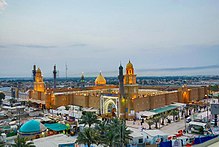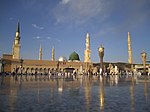Great Mosque of Kufa
| Mosque of Kufa | |
|---|---|
| |
Saad Ibn Abi Waqqas | |
| Completed | 670 CE |
| Specifications | |
| Interior area | 11,000 square metres (120,000 sq ft) |
| Dome(s) | 1 |
| Minaret(s) | 4 |
| Shrine(s) | 3 |
| Website | |
| www | |
The Great Mosque of Kufa (
History

The first main mosque of Kufa was built with the city's foundation in 638.
In 670, the governor of the city,
It was in the Great Mosque of Kufa that the first Abbasid caliph was formally proclaimed in 749.[7] By the 14th century, when Ibn Battuta visited the site, only the foundations of the old governor's palace still remained.[4] The mosque underwent various other restorations throughout its history.[7] The golden dome standing today over the tombs, as well as the surrounding tilework decoration, was added during the Safavid period in the 17th and 18th centuries.[5] In the midst of the 19th century AD, Sultan Abdul-Ali Khan, Adib al-Malik of Iran, journeyed to the Kufa and Al-Sahla mosques in the holy city of Kufa, during the Ottoman era. It is important to acknowledge the conflicts that afflicted these two Ottoman mosques over time, surpassing religious and doctrinal differences and frequently escalating into disagreements, confrontations, and instances of violence.[8]

In 1998, head of Dawoodi Bohra community, Mohammed Burhanuddin started reconstructing and renovating the mosque.[9][10]: 97, 106 Work was completed in early 2010.[9] The renovation included decorations with gold and silver, the mihrab being made with a gold zari, and the whole interior being surrounded with verse of the Quran. In addition, the courtyard is covered in white marble from Makrana, India.[9]
Today, the outer wall of the mosque, with semi-circular buttresses, probably still dates from the early period of the building's history.[5][7] The building's floor level has also been raised from its earlier level.[7]
Architecture
Mosque

The area of the building measures approximately 11,000 square metres (120,000 sq ft).[11] The historic mosque has a quadrangular layout, measuring 110 by 112 by 109 by 112 metres (361 ft × 367 ft × 358 ft × 367 ft).[12] It has semi-circular bastions along its outer walls, three circular (three-quarter-round) towers at its corners, and historically had one minaret, according to investigations of the site in the 20th century.[12] The present-day mosque has four minarets.[13] Small differences were found among the four walls of the mosque. The southern wall, which faced the Qibla, measured approximately 110 m in length. The back wall spanned 109 m, while the remaining two side walls measured 116 m each. These walls, towering in height, were reinforced by semi-circular towers on their exteriors.[14]
The mosque has five gates: Gate of the Threshold (Bāb al-Sudda), Gate of Kinda (Bāb Kinda), Gate of al-Anmat (Bāb al-Anmāṭ), Gate of Hani ibn Urwa, and the Gate of the Snake (Bāb al-Thu‘bān) or Gate of the Elephant (Bāb al-Fīl).[15][11]
The historic mosque structure has similarities to the design of the palaces of pre-Islamic Persia.[6] According to a description by Ibn al-Athir (d. 1233), its ceiling was taken from a Persian palace and resembled the ceiling of a Byzantine church.[16]
Palace remains
Archeological excavations in the 20th century have revealed the presence of an even larger quadrangular structure, measuring 168.20 by 169.98 metres (551.8 ft × 557.7 ft), that was once attached to the south side of the mosque.[12] This structure has been identified as the Palace of Sa'd ibn Abī Waqqāṣ, which historical sources say was originally built at the same time as the original mosque after the city's foundation (c. 638).[12] Also known as the Qaṣr al-Imāra[12] or Dar al-Imāra ('Palace of the Governor'), it was rebuilt by Ziyad ibn Abihi at the same time as the mosque in 670.[4] Archeologists identified three main layers of construction at the site, which were often reconstructions along the same lines as the preceding layer. The remains of the palace are still visible today but are not generally accessible and are threatened by underground water seeping into the site.[12]
The palace was composed of an outer enclosure wall (attached to the mosque) and an inner enclosure (measuring approximately 110 by 110 metres (360 ft × 360 ft).[12] Like the mosque, the outer walls of these enclosures had semi-circular bastions and circular corner towers, although the oldest layer of construction at the inner enclosure featured square towers that were rebuilt in rounded form over the first foundations.[12] The inner enclosure, which was accessed via a main entrance on its north side, was filled with rooms and structures that were modified in several periods. Its main features included a central square courtyard from which a triple-arched entrance on each side led to other rooms.[12] The entrance on the south side led to a quadrangular hall with an iwan-like or basilical layout divided by columns into three aisles. This led in turn to a large square chamber further south that was probably domed.[12][4]
Religious significance
This section is in prose. is available. (July 2018) |
See also
- Holiest sites in Shia Islam
- Prophet's Mosque in Medina
- Masjid al-Haram in Mecca
- Al-Aqsa in Jerusalem
- Imam Husayn Shrine in Karbala
- Al-Hussein Mosquein Cairo
References
- ^ "Hundreds of thousands' Friday assemblage in Masjid-e-Uzma Kufa". Jafariyanews.com. Archived from the original on 2 August 2016. Retrieved 20 November 2008.
- ISBN 978-90-04-30207-5.
- ISBN 978-90-04-03813-4.
- ^ ISBN 9780195309911.
- ^ ISBN 9781134613663.
- ^ ISBN 9780761479291.
- ^ ISBN 978-90-04-15388-2.
- ISSN 2313-0059.
- ^ a b c Kartikeya (21 March 2010). "Bohras help War-ravaged Kufa get back its glory". Times of India. Archived from the original on 29 October 2017. Retrieved 15 September 2017.
- ISBN 9789231000287. Archivedfrom the original on 7 June 2019. Retrieved 1 Jun 2020 – via halshs.com.
- ^ a b "General Facts and Numbers". The Official Website of Secretariat of Al-Kufa Mosque and it Shrines. Archived from the original on 2010-07-31. Retrieved 2009-03-01.
- ^ a b c d e f g h i j Di Cesare, Michelina. "A Survey of the Great Mosque-Palace Complex of Kufa (2019) - Fondation Max van Berchem". Fondation Max Van Berchem. Retrieved 2023-10-16.
- ^ "General Facts and Numbers". The Official Website of Secretariat of Al-Kufa Mosque and it Shrines. Archived from the original on 2010-07-31. Retrieved 2009-03-01.
- ISSN 2191-0243.
- from the original on 2012-07-01. Retrieved 2017-09-20.
- ISBN 9781438408125. Retrieved 27 March 2022.
- ISBN 978-0-87395-272-9.
- ^ a b c "The Establishment of the Mosque". The Official Website of Secretariat of Al-Kufa Mosque and it Shrines. Archived from the original on 2010-07-31. Retrieved 2009-03-01.
- ^ al-Qummi, Ja'far ibn Qūlawayh (2008). Kāmil al-Ziyārāt. trans. Sayyid Mohsen al-Husaini al-Mīlāni. Shiabooks.ca Press. pp. 66–67.
- ISBN 978-1-59698-029-7.
the fight for jerusalem.
- ^ al-Qummi, Ja'far ibn Qūlawayh (2008). "8". Kāmil al-Ziyārāt. trans. Sayyid Mohsen al-Husaini al-Mīlāni. Shiabooks.ca Press. p. 47.
- ^ al-Qummi, Ja'far ibn Qūlawayh (2008). "8". Kāmil al-Ziyārāt. trans. Sayyid Mohsen al-Husaini al-Mīlāni. Shiabooks.ca Press. p. 44.
- ^ "The Establishment of the Mosque". The Official Website of Secretariat of Al-Kufa Mosque and it Shrines. Archived from the original on 2010-07-31. Retrieved 2009-03-01.
It is the one the sole four dignified mosques, to which Muslims must travel, and it comes in the third place after the Mosque the Kaaba, the mosque of Prophet


